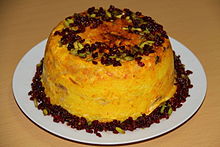List of Iranian foods
This is a list of Iranian foods and dishes. Iranian cuisine (Including Persian cuisine) comprises the cooking traditions of Iran. Iran's culinary culture has historically interacted with the cuisines of the neighboring regions, including Caucasian cuisine, Turkish cuisine, Levantine cuisine, Greek cuisine, Central Asian cuisine, and Russian cuisine.[1][2][3][4] Through the various Persianized Muslim sultanates and the Central Asian Mughal dynasty, aspects of Iranian cuisine were also adopted into Indian and Pakistani cuisines.[5][6][7]
Typical Iranian main dishes are combinations of rice with meat, vegetables, and nuts. Herbs are frequently used, along with fruits such as plums, pomegranates, quince, prunes, apricots, and raisins. Characteristic Iranian flavorings such as saffron, dried lime and other sources of sour flavoring, cinnamon, turmeric, and parsley are mixed and used in various dishes.
Outside Iran, Iranian cuisine is especially found in cities of the Iranian diaspora such as London, the San Francisco Bay Area, Toronto,[8][9][10][11] Houston and especially Los Angeles and its environs.[8][9][12]
Iranian foods
Bread
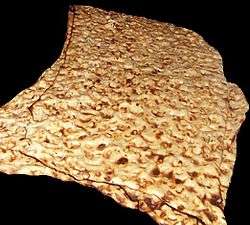 |
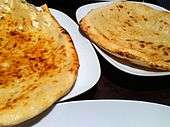 | |
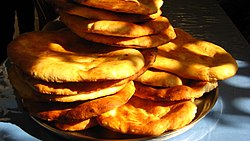 |
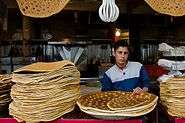 |
|
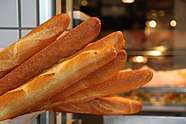 |
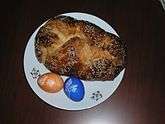 |
Rice
| Method | Description |
|---|---|
| Polow and chelow | Chelow is plain rice served as an accompaniment to a stew or kebab, while polow is rice mixed with something. They are, however, cooked in the same way. Rice is prepared by soaking in salted water and then boiling it. The parboiled rice (called chelow) is drained and returned to the pot to be steamed. This method results in an exceptionally fluffy rice with the rice grains separated and not sticky. A golden crust, called tadig, is created at the bottom of the pot using a thin layer of bread or potato slices. Often, tadig is served plain with only a rice crust. Meat, vegetables, nuts, and fruit are sometimes added in layers or mixed with the chelow and then steamed. When chelow is in the pot, the heat is reduced and a thick cloth or towel is placed under the pot lid to absorb excess steam. |
| Kateh | Rice that is cooked until the water is absorbed completely. It is the traditional dish of Gilan Province. |
| Dami | Rice that is cooked almost the same as kateh, but at the start, ingredients that can be cooked thoroughly with the rice (such as grains and beans) are added. While making kateh, the heat is reduced to a minimum until the rice and other ingredients are almost cooked. If kept long enough on the stove without burning and over-cooking, dami and kateh can also produce tadig. A special form of dami is tachin, which is a mixture of yogurt, chicken (or lamb) and rice, plus saffron and egg yolks. |
Polow and dami
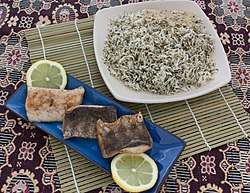 |
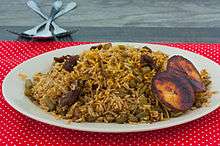 |
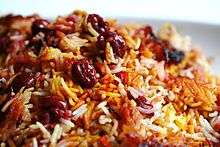 |
|
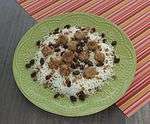 |
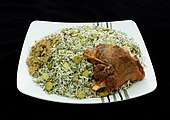 |
||
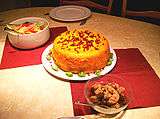 |
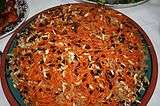 |
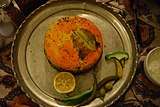 |
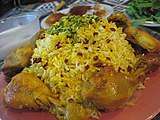 |
Kebab
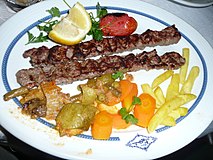 |
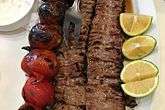 | |
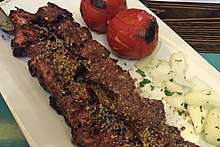 |
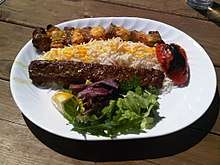 |
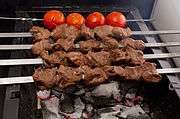 |
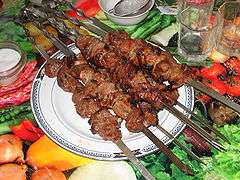 |
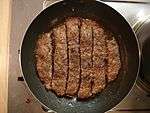 |
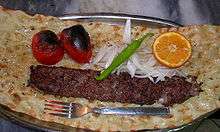 |
Stew
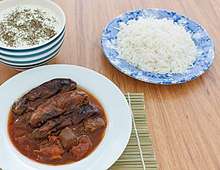 |
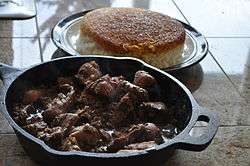 |
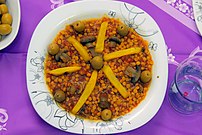 |
|
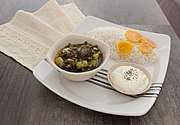 |
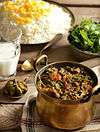 |
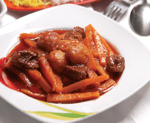 | |
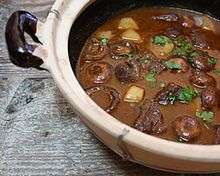 |
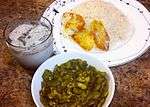 |
 |
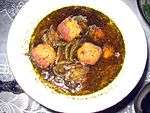 |
Soup and āsh
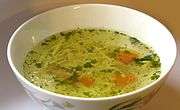 |
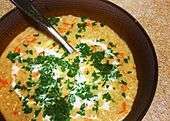 |
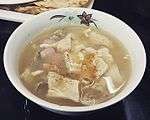 |
.jpg) |
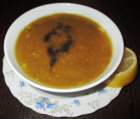 | |
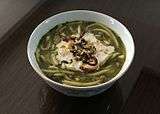 |
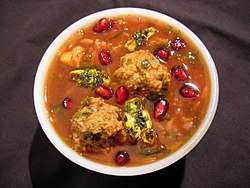 |
|
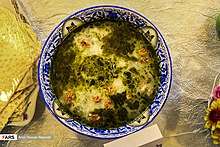 |
_cuisine.jpg) |
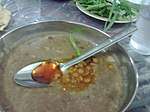 |
Other
.jpg) |
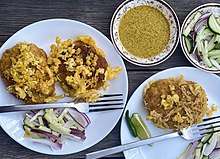 |
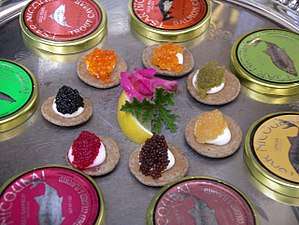 | |
.jpg) |
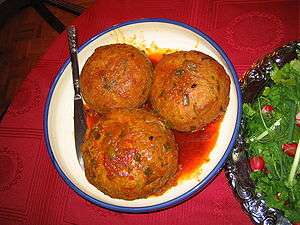 |
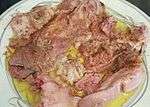 | |
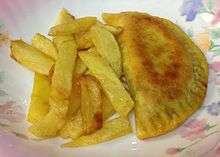 |
_with_sliced_tomato_and_kosher_dills.jpg) |
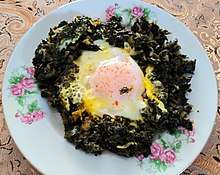 |
Sirabij: A type of garlic omelette. |
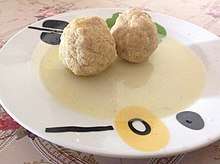 |
_Pizza.jpg) |
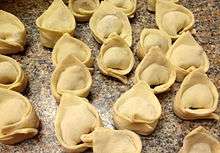 | |
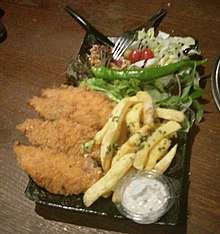 |
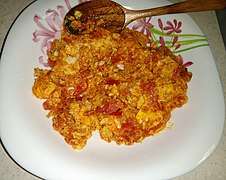 |
.jpg) |
 |
Appetizers
.jpg) |
 |
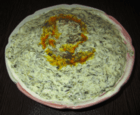 |
|
 |
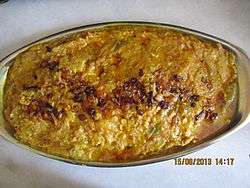 |
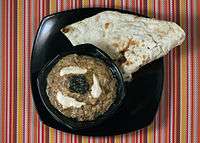 |
Desserts
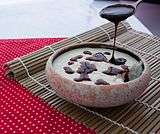 |
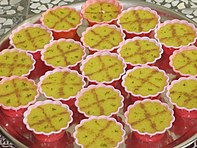 |
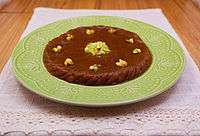 |
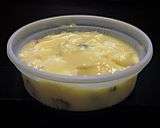 |
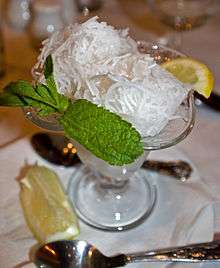 |
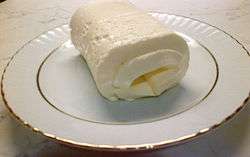 |
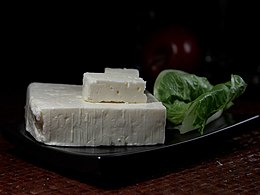 |
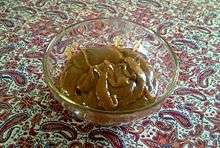 |
Snacks
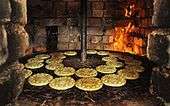 |
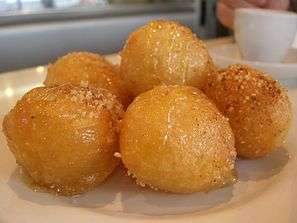 |
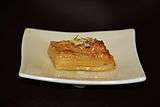 |
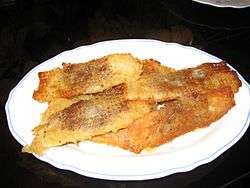 |
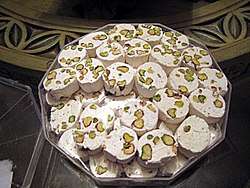 |
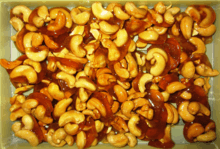 |
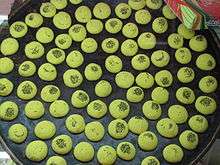 | |
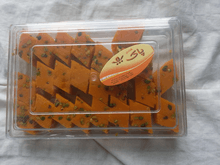 |
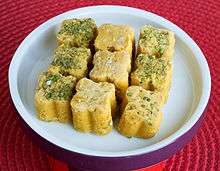 |
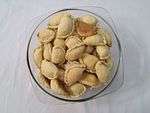 |
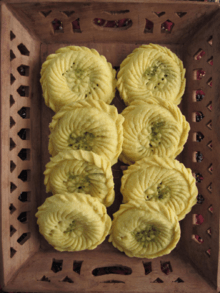 |
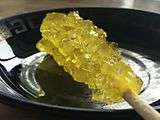 |
.jpg) |
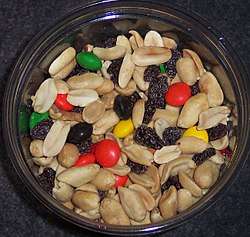 |
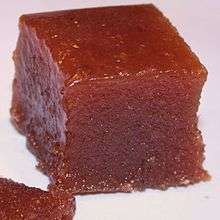 |
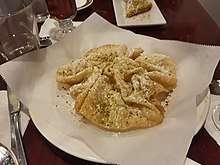 |
.jpg) |
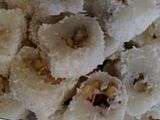 |
Drinks
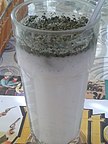 |
.jpg) |
.jpg) | |
.jpg) |
 |
 |
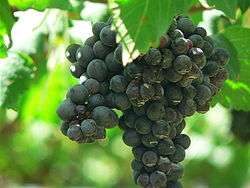 |
See also
References
- "Persian Cuisine, a Brief History". Culture of IRAN. Retrieved 2016-01-08.
- electricpulp.com. "ĀŠPAZĪ – Encyclopaedia Iranica". www.iranicaonline.org.
- "Iranian Food". Archived from the original on 14 April 2014. Retrieved 13 April 2014.
- "Culture of IRAN". Cultureofiran.com. Retrieved 13 April 2014.
- Achaya, K. T. (1994). Indian Food: A Historical Companion. Oxford University Press. p. 11.
- Stanton; et al. (2012). Cultural Sociology of the Middle East, Asia, and Africa: An Encyclopedia. SAGE Publications. p. 103. ISBN 978-1452266626.
- Mina Holland (6 March 2014). The Edible Atlas: Around the World in Thirty-Nine Cuisines. Canongate Books. pp. 207–. ISBN 978-0-85786-856-5.
- Dehghan, Saeed Kamali (February 3, 2016). "Top five Persian restaurants in London". The Guardian. ISSN 0261-3077. Retrieved February 16, 2016.
- Ta, Lien (November 27, 2011). "The Best Persian Food In LA (PHOTOS)". HuffPost.
- "Bay Area chef circles back to childhood with Iranian breads". San Francisco Chronicle. Retrieved March 3, 2018.
- "The 10 best new restaurants in Toronto in 2013". The Globe and Mail. Retrieved February 16, 2016.
- Whitcomb, Dan (January 4, 2018). "Los Angeles' large Iranian community cheers anti-regime protests". Reuters.
- Tales of a Kitchen (March 5, 2013). "Persian date bread with turmeric and cumin (Komaj)".
- Shafia, Louisa. "Morasa polo". The New Persian Kitchen.
- "Jeweled Rice (Morasa Polo)". Parisa's Kitchen. October 9, 2014.
- Daniel, Elton L. Mahdī, ʻAlī Akbar. Culture and Customs of Iran. p. 153.CS1 maint: multiple names: authors list (link)
- Batmanglij, Najmieh. "Adas polow". A Taste of Persia: An Introduction to Persian Cooking. p. 96.
- Batmanglij, Najmieh. "Baqala polow". A Taste of Persia: An Introduction to Persian Cooking. p. 104.
- Batmanglij, Najmieh. Food of Life: A Book of Ancient Persian and Modern Iranian Cooking and Ceremonies. p. 103.
- "Saffron and lemon chicken (Joojeh Kabab)". Irish Times. Retrieved 2016-07-02.
- Burke, Andrew. Elliott, Mark. "MAIN COURSES: Kabab". Iran. Ediz. Inglese. p. 84.CS1 maint: multiple names: authors list (link)
- Sally Butcher (Oct 10, 2013). "Kebab-e-Chenjeh". Snackistan.
- Aashpazi.com. "KABAB TABEI".
- Vatandoust, Soraya. "Khoresh-e Karafs". Authentic Iran: Modern Presentation of Ancient Recipes. p. 132.
- Ramazani, Nesta. "Khoresht-e aloo". Persian Cooking: A Table of Exotic Delights. p. 138.
- Dana-Haeri, Jila. Lowe, Jason. Ghorashian, Shahrzad. "Glossary". New Persian Cooking: A Fresh Approach to the Classic Cuisine of Iran. p. 221.CS1 maint: multiple names: authors list (link)
- Goldstein, Joyce. "Persian Stew with Lamb or Beef, Spinach, and Prunes". The New Mediterranean Jewish Table: Old World Recipes for the Modern Home. p. 319.
- Ramazani, Nesta. Persian Cooking: A Table of Exotic Delights. p. 130.
- Dana-Haeri, Jila. Ghorashian, Shahrzad. Lowe, Jason. "Khoresht-e gharch". New Persian Cooking: A Fresh Approach to the Classic Cuisine of Iran. p. 72.CS1 maint: multiple names: authors list (link)
- Ramazani, Nesta. "Chicken Soup (Soup-e Morgh)". Persian Cooking: A Table of Exotic Delights. p. 38.
- Vatandoust, Soraya. "Soup-e Jow". Authentic Iran: Modern Presentation of Ancient Recipes. p. 22.
- Meftahi, Ida. Gender and Dance in Modern Iran: Biopolitics on Stage. p. 72.
sirabi-va-shirdun
- Vatandoust, Soraya. "Zeytoon Parvardeh". Authentic Iran: Modern Presentation of Ancient Recipes. p. 44.
- Vatandoust, Soraya. "Chapter 8". Authentic Iran: Modern Presentation of Ancient Recipes. p. 186.
- Ramazani, Nesta. "Rice Flour Cookies (Nan-e Berenji)". Persian Cooking: A Table of Exotic Delights. p. 227.
- Marks, Gil. "Shirini". Encyclopedia of Jewish Food.
- Butcher, Sally. "Peckham Delight". Veggiestan: A Vegetable Lover's Tour of the Middle East.
- Edelstein, Sari. Food, Cuisine, and Cultural Competency for Culinary, Hospitality, and Nutrition Professionals. p. 595.
aab-e havij, a carrot juice
- Duguid, Naomi. Taste of Persia: A Cook's Travels Through Armenia, Azerbaijan, Georgia, Iran, and Kurdistan. p. 353.
...havij bastani, a kind of ice cream float, made with Persian ice cream and carrot juice
- J. & A. Churchill. The Pharmaceutical Journal and Transactions, Volume 37. p. 385.
Khakshir is imported from Persia...
External links
| Wikimedia Commons has media related to Cuisine of Iran. |
